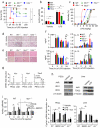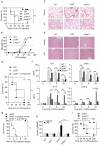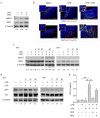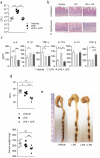Aryl hydrocarbon receptor control of a disease tolerance defence pathway
- PMID: 24930766
- PMCID: PMC4098076
- DOI: 10.1038/nature13323
Aryl hydrocarbon receptor control of a disease tolerance defence pathway
Abstract
Disease tolerance is the ability of the host to reduce the effect of infection on host fitness. Analysis of disease tolerance pathways could provide new approaches for treating infections and other inflammatory diseases. Typically, an initial exposure to bacterial lipopolysaccharide (LPS) induces a state of refractoriness to further LPS challenge (endotoxin tolerance). We found that a first exposure of mice to LPS activated the ligand-operated transcription factor aryl hydrocarbon receptor (AhR) and the hepatic enzyme tryptophan 2,3-dioxygenase, which provided an activating ligand to the former, to downregulate early inflammatory gene expression. However, on LPS rechallenge, AhR engaged in long-term regulation of systemic inflammation only in the presence of indoleamine 2,3-dioxygenase 1 (IDO1). AhR-complex-associated Src kinase activity promoted IDO1 phosphorylation and signalling ability. The resulting endotoxin-tolerant state was found to protect mice against immunopathology in Gram-negative and Gram-positive infections, pointing to a role for AhR in contributing to host fitness.
Figures






Comment in
-
"Nuts and bolts" of disease tolerance.Immunity. 2014 Aug 21;41(2):176-8. doi: 10.1016/j.immuni.2014.07.011. Immunity. 2014. PMID: 25148020
-
AhR: far more than an environmental sensor.Cell Cycle. 2014;13(17):2645-6. doi: 10.4161/15384101.2014.954219. Cell Cycle. 2014. PMID: 25486345 Free PMC article. No abstract available.
-
AHR: A Temple of Tolerance to Toxemia.Sci Transl Med. 2014 Aug 20;6(250):250ec142. doi: 10.1126/scitranslmed.3010122. Sci Transl Med. 2014. PMID: 29983859 Free PMC article. No abstract available.
References
-
- Fan H, Cook JA. Molecular mechanisms of endotoxin tolerance. J. Endotoxin. Res. 2004;10:71–84. - PubMed
-
- Pena OM, Pistolic J, Raj D, Fjell CD, Hancock RE. Endotoxin tolerance represents a distinctive state of alternative polarization (M2) in human mononuclear cells. J. Immunol. 2011;186:7243–7254. - PubMed
-
- Krausgruber T, et al. IRF5 promotes inflammatory macrophage polarization and Th1-Th17 responses. Nat. Immunol. 2011;12:231–238. - PubMed
-
- Biswas SK, Lopez-Collazo E. Endotoxin tolerance: new mechanisms, molecules and clinical significance. Trends Immunol. 2009;30:475–487. - PubMed
Publication types
MeSH terms
Substances
Grants and funding
LinkOut - more resources
Full Text Sources
Other Literature Sources
Molecular Biology Databases
Research Materials
Miscellaneous

